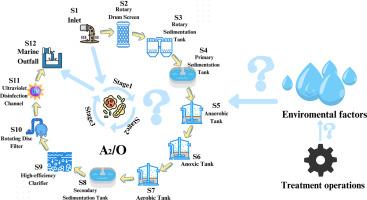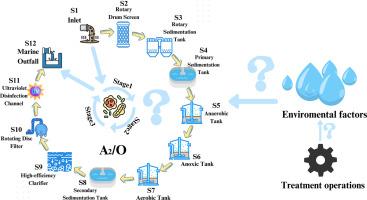整个 A2/O 废水处理过程中微生物群落的变化及其驱动因素 - 群落多样性减少,但某些病原体的比例增加
IF 11.4
1区 环境科学与生态学
Q1 ENGINEERING, ENVIRONMENTAL
引用次数: 0
摘要
微生物在去除污染物和稳定水质方面发挥着至关重要的作用。然而,对废水处理不同阶段的微生物变异性及其驱动因素的研究十分有限。本研究对整个 A2/O 废水处理过程(包括 3 个阶段(12 个步骤))中水的理化性质和细菌群落的组成进行了深入研究。结果显示,α 多样性显著降低,而β 多样性在各个阶段基本保持不变。α多样性主要受溶解氧(DO)和 pH 值的影响,其中溶解氧的影响最为显著,而β多样性则主要受 COD、BOD5、NH4-N、TN 和 TP 等营养条件的制约。此外,相对丰度、LEFSe、方差和功能预测分析表明,某些病原菌(如军团菌、钩端螺旋体)的相对丰度显著增加,与大肠埃希菌相比,它们在不同处理步骤中表现出不同的去除特性。即使在紫外线消毒后,这些病原体仍然存在,凸显了潜在的致病风险,值得更多关注。此外,这项研究还有助于探索污水处理不同阶段(步骤)微生物变异性这一研究相对不足的领域,尤其是微生物群落如何对操作过程和环境条件做出反应。这将为解决实际工艺中遇到的水处理安全挑战提供有价值的指导。本文章由计算机程序翻译,如有差异,请以英文原文为准。


Changes in microbial communities across the whole A2/O wastewater treatment process and their drivers—Reduced community diversity but increased proportion of certain pathogens
Microorganisms play a crucial role in pollutant removal and water quality stabilizing. However, limited research exists on the microbial variability and the factors driving it at different stages of wastewater treatment. In this study, the physicochemical properties of water and the composition of bacterial communities were thoroughly investigated across the entire A2/O wastewater treatment process, encompassing 3 stages (12 steps). The results revealed a significant reduction in alpha diversity, whereas the beta diversity remained largely unchanged across stages. Alpha diversity was primarily influenced by dissolved oxygen (DO) and pH, with DO having the most notable influence, while beta diversity was mainly constrained by nutrient conditions such as COD, BOD5, NH4-N, TN, and TP. Additionally, analyses of relative abundance, LEfSe, variance, and functional prediction indicated a significant increase in the relative abundance of certain pathogenic bacteria (e.g., Legionella, Leptospira), exhibiting different removal characteristics compared to Escherichia coli across various treatment steps. Even after UV disinfection, these pathogens persist, highlighting a potential pathogenic risk, which deserves more attention. In addition, this study helps explore the relatively under-researched area of microbial variability at different stages (steps) of wastewater treatment, especially in terms of how microbial communities respond to operational processes and environmental conditions. This will offer valuable guidance for addressing water treatment safety challenges encountered in real-world processes.
求助全文
通过发布文献求助,成功后即可免费获取论文全文。
去求助
来源期刊

Water Research
环境科学-工程:环境
CiteScore
20.80
自引率
9.40%
发文量
1307
审稿时长
38 days
期刊介绍:
Water Research, along with its open access companion journal Water Research X, serves as a platform for publishing original research papers covering various aspects of the science and technology related to the anthropogenic water cycle, water quality, and its management worldwide. The audience targeted by the journal comprises biologists, chemical engineers, chemists, civil engineers, environmental engineers, limnologists, and microbiologists. The scope of the journal include:
•Treatment processes for water and wastewaters (municipal, agricultural, industrial, and on-site treatment), including resource recovery and residuals management;
•Urban hydrology including sewer systems, stormwater management, and green infrastructure;
•Drinking water treatment and distribution;
•Potable and non-potable water reuse;
•Sanitation, public health, and risk assessment;
•Anaerobic digestion, solid and hazardous waste management, including source characterization and the effects and control of leachates and gaseous emissions;
•Contaminants (chemical, microbial, anthropogenic particles such as nanoparticles or microplastics) and related water quality sensing, monitoring, fate, and assessment;
•Anthropogenic impacts on inland, tidal, coastal and urban waters, focusing on surface and ground waters, and point and non-point sources of pollution;
•Environmental restoration, linked to surface water, groundwater and groundwater remediation;
•Analysis of the interfaces between sediments and water, and between water and atmosphere, focusing specifically on anthropogenic impacts;
•Mathematical modelling, systems analysis, machine learning, and beneficial use of big data related to the anthropogenic water cycle;
•Socio-economic, policy, and regulations studies.
 求助内容:
求助内容: 应助结果提醒方式:
应助结果提醒方式:


